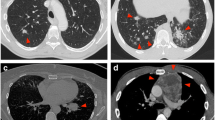Purpose: The diagnostic accuracy and rate of complications of CT-guided core biopsies (CB) from suspected tumors of the chest were compared to the accuracy a complications of fine-needle aspiration biopsies (FNAB).
Methods: The accuracy in the diagnosis of a benign or malignant lesion of 79 FNAB (19.5 G self-aspirating cutting needle) and of 83 CB (18 G automated core biopsy) and the rates of pneumothorax, pleural drainage and hemoptysis were retrospectively evaluated.
Results: With FNAB, the sensitivity for malignant lesions was 62.1 % and the accuracy 68.4 %. With CB the sensitivity amounted to 85.9 % and accuracy to 86.7 %. The rate of pneumothorax was 25.3 % following FNAB, with a drainage rate of 5.1 % compared to 19.3 % and 6.0 %, respectively, following CB. The rate of pneumothorax and drainage increased with increasing path length through aerated lung. In advanced emphysema, the pneumothorax rate did not increase; however, in pneumothoraces, pleural drainage was mandatory in 20 % of FNAB and in 100 % of CB. Hemoptysis without any therapeutic consequences occurred in 3.8 % following FNAB and in 6.0 % following CB.
Conclusions: With CB diagnostic accuracy can be clearly increased without an obvious increase in the complication rate. However, in patients with obvious emphysema, the pleural drainage rate of pneumothorax may be higher following CB.
Fragestellung: In dieser Arbeit sollten die diagnostische Treffsicherheit und die Komplikationsrate von CT-gesteuerte Stanzbiopsien (STB) thorakaler Raumforderungen mit denen der Feinnadelaspirationsbiopsien (FNAB) verglichen werden.
Methodik: Die Treffsicherheit in der Diagnose einer benignen oder malignen Raumforderung der mittels 79 FNAB (19,5 gg. selbst aspirierende Schneidbiopsienadel) und mittels 83 STB (18 gg. automatisierte Stanzbiopsie) gewonnenen Biopsien sowie die Pneumothorax-, Drainage- und Hämoptysefrequenz wurden retrospektiv ausgewertet.
Ergebnisse: Mit der FNAB wurden eine Sensitivität für maligne Läsionen von 62,1 % und eine Treffsicherheit von 68,4 % erzielt. Mit der STB betrugen die Sensitivität 85,9 % und die Treffsicherheit 86,7 %. Die Pneumothoraxrate betrug nach FNAB 25,3 % bei einer Drainagerate von 5,1 %, nach STB jeweils 19,3 % und 6,0 %. Die Pneumothorax- und Drainagenrate stiegen mit zunehmendem Punktionsweg durch belüftetes Lungenparenchym an. Bei ausgeprägtem Lungenemphysem nahm die Pneumothoraxrate nicht zu; nach eingetretenem Pneumothorax war jedoch bei der FNAB in 20 %, bei der STB in 100 % der Fälle eine Drainagenanlage erforderlich. Hämoptysen ohne weitere therapeutische Konsequenz traten nach FNAB in 3,8 % und nach STB in 6,0 % auf.
Schlußfolgerung: Durch Einsatz der STB kann die diagnostische Treffsicherheit deutlich erhöht werden, ohne daß die Komplikationsrate nennenswert ansteigt. Bei Patienten mit deutlichem Emphysem ist jedoch bei eingetretenem Pneumothorax mit einer höheren Drainagepflichtigkeit nach STB zu rechnen.
Similar content being viewed by others
Author information
Authors and Affiliations
Rights and permissions
About this article
Cite this article
Erlemann, R., Zimmerschied, A., Gilger, F. et al. Punch biopsy or fine needle aspiration biopsy in percutaneous puncture. Radiologe 38, 126–134 (1998). https://doi.org/10.1007/s001170050335
Issue Date:
DOI: https://doi.org/10.1007/s001170050335




